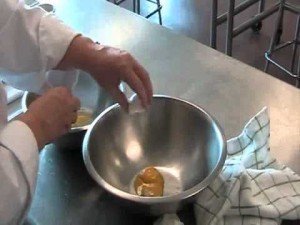If you can poach an egg, toast an English Muffin and grill some Canadian Bacon, you can make an Egg McMuffin. But, what if you added a velvety smooth hollandaise sauce? Then, you’ve got Eggs Benedict, an upscale breakfast delicacy that can’t be gotten from the drive-thru window.
What is Eggs Benedict WITHOUT hollandaise sauce? It’s just a breakfast sandwich that any fast food employee can prepare. The difference between the dollar menu item and a professionally made breakfast lies in knowing how to make this delicate sauce that takes advantage of the science of emulsification.
Hollandaise sauce and all the small sauces that are derived from it involve an emulsification process. An emulsification is the mixing of two unmixable items as demonstrated in other procedures like how to make mayonnaise which uses the same science.
Egg yolks contain lecithin, a natural emulsifier. It brings together warm clarified butter, a small amount of water, lemon juice or vinegar and the yolks. The problem is that egg yolks contain fat. Fat and water don’t normally mix. Lecithin in the egg yolks brings the two unmixable items together in a permanent emulsion.
When the yolks are vigorously whipped with the liquids, the warm butter is slowly added and the lecithin coats the individual fat droplets and holds them in suspension in the liquid. This process is the difference between having a great hollandaise sauce and just creating scrambled eggs with melted butter in them.
If you are curious about the correct way to clarify butter, review the previous class “All The Butter Facts From Culinary College”
A properly made hollandaise is smooth, buttery, pale lemon yellow colored and very rich. It must be absolutely lump free and not exhibit any signs of separation. It should be frothy and light, not heavy like mayonnaise.
What is Eggs Benedict with a badly made sauce? It’s a terrible mess! Temperatures play an important role in the proper production of hollandaise. As the egg yolks and liquid are whisked together, they are cooked over a double boiler until they thicken to the consistency of slightly whipped cream. Do not overheat this mixture. The object is NOT to cook the eggs but to give enough heat for the two unmixable items to join together. Even slightly cooked eggs lose their ability to emulsify. That’s why the clarified butter should be warm, but not so hot as to cook the eggs.
Eggs take on the most air and emulsify at about 110F, so this process is made much easier by controlling the heat and using warm clarified butter of about 110 degrees.
The procedure for making a great hollandaise sauce:
1) For 3 egg yolks, use 1 ounce of water and whisk them together in a glass or stainless steel bowl.
2) Place the mixture over double boiler and whisk continually.
3) As the yolks warm, the mixture will thicken. When it leaves a trail in the surface, it’s thick enough
4) Start adding the warm clarified butter, but only a few drops at a time to delicately begin the process.
5) Once the emulsification starts, you’ll notice the egg yolks getting lighter, fluffier, and increase in volume considerably.
6) Add vinegar, lemon juice or a small amount of tomato juice. The acidic product will help coagulate proteins in the eggs and give greater structure to the sauce.
7) If necessary, strain the sauce to remove any small lumps of scrambled eggs before service.
What is Eggs Benedict WITH hollandaise sauce? It’s the perfect brunch item to class up your weekend breakfast and can be just the beginning of all the inspirations you might have. Add a crab cake and you’ve got Eggs Chesapeake. You can also add poached asparagus spears, slices of tomato, smoked salmon, even sliced steak to make a classy breakfast that the McFast food restaurant can never match!
Discover the difference between how professionals and home cooks are taught in my next
FREE Webinar Workshop
Claim your FREE Spot for the next webinar session by CLICKING HERE


